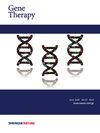CRISPR targeting of SNPs associated with age-related macular degeneration in ARPE-19 cells: a potential model for manipulating the complement system
IF 4.5
3区 医学
Q1 BIOCHEMISTRY & MOLECULAR BIOLOGY
引用次数: 0
Abstract
Age-related Macular degeneration (AMD) is a major cause of vision loss and is linked to several predisposing single nucleotide polymorphisms (SNPs). CRISPR-mediated genome editing offers the potential to target negatively associated SNPs in an allele-specific manner, necessitating the need for a relevant cell model. The ARPE-19 cell line, with its stable monolayer growth and retinal pigment epithelium (RPE) characteristics, serves as an ideal model for AMD studies. Chronic inflammation and complement system dysregulation are implicated in AMD pathogenesis. Most genetic variations associated with AMD are in complement genes, suggesting their regulatory role. In this study, we conducted targeted PCRs to identify AMD-related SNPs in ARPE-19 cells and used CRISPR constructs to assess allele-specific activity. Guide RNA sequences were cloned into an EF-1-driven SpCas9 vector and packaged into lentivirus. Targeting efficiencies were evaluated with TIDE analysis, and allele-specificity was measured with NGS analysis 30 days post-transduction. Our results showed varying targeting efficiencies depending on guide RNA efficacy. For example, TIDE analysis of CFH SNPs rs1061170 and rs1410996 revealed efficiencies of 35.5% and 33.8%, respectively. CFB SNP rs4541862 showed efficiencies from 3% to 36.7%, and rs641153 ranged from 3.4% to 23.8%. Additionally, allele-specific targeting of AMD-related SNPs rs1061170, rs1410996, rs4541862, and rs641153 ranged from 48% to 52% in heterozygous differentiated ARPE-19 cells. These findings demonstrate the potential to manipulate the complement system in an AMD model by targeting disease-associated SNPs in an allele-specific manner, offering a promising therapeutic approach.

CRISPR靶向ARPE-19细胞中与年龄相关性黄斑变性相关的snp:操纵补体系统的潜在模型
年龄相关性黄斑变性(AMD)是视力丧失的主要原因,与几种易感的单核苷酸多态性(snp)有关。crispr介导的基因组编辑提供了以等位基因特异性方式靶向负相关snp的潜力,因此需要相关的细胞模型。ARPE-19细胞系具有稳定的单层生长和视网膜色素上皮(RPE)特性,是AMD研究的理想模型。慢性炎症和补体系统失调与AMD的发病有关。大多数与AMD相关的遗传变异都在补体基因中,表明它们具有调节作用。在本研究中,我们在ARPE-19细胞中进行了靶向pcr鉴定amd相关snp,并使用CRISPR构建物评估等位基因特异性活性。将引导RNA序列克隆到ef -1驱动的SpCas9载体中,并包装到慢病毒中。用TIDE分析评估靶向效率,并在转导后30天用NGS分析测量等位基因特异性。我们的结果显示不同的靶向效率取决于向导RNA的功效。例如,CFH snp rs1061170和rs1410996的TIDE分析效率分别为35.5%和33.8%。CFB SNP rs4541862的效率范围为3% ~ 36.7%,rs641153的效率范围为3.4% ~ 23.8%。此外,在杂合分化的ARPE-19细胞中,amd相关snp rs1061170、rs1410996、rs4541862和rs641153的等位基因特异性靶向范围从48%到52%不等。这些发现表明,通过以等位基因特异性的方式靶向疾病相关的snp,可以在AMD模型中操纵补体系统,提供了一种有希望的治疗方法。
本文章由计算机程序翻译,如有差异,请以英文原文为准。
求助全文
约1分钟内获得全文
求助全文
来源期刊

Gene Therapy
医学-生化与分子生物学
CiteScore
9.70
自引率
2.00%
发文量
67
审稿时长
4-8 weeks
期刊介绍:
Gene Therapy covers both the research and clinical applications of novel therapeutic techniques based on a genetic component. Over the last few decades, significant advances in technologies ranging from identifying novel genetic targets that cause disease through to clinical studies, which show therapeutic benefit, have elevated this multidisciplinary field to the forefront of modern medicine.
 求助内容:
求助内容: 应助结果提醒方式:
应助结果提醒方式:


